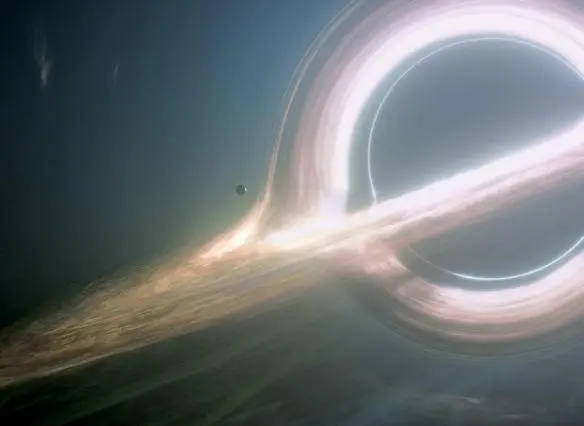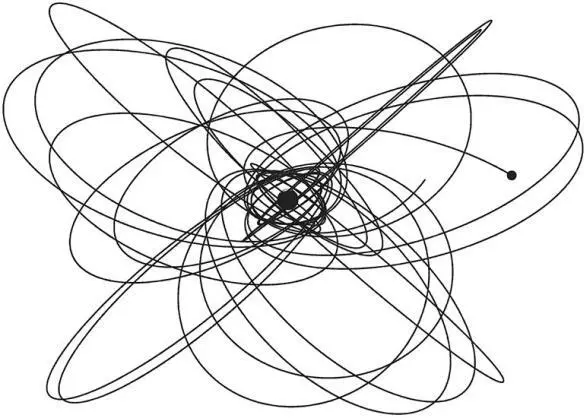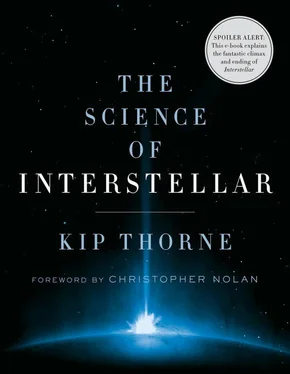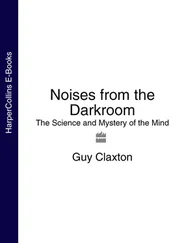
Fig. 9.9. Gargantua with the infinitesimally thin paint-swatch disk (Fig. 9.7) replaced by a more realistic, infinitesimally thin accretion disk. [From Eugénie von Tunzelmann’s artistic team at Double Negative.]
The artistic team at Double Negative then gave the disk the texture and surface relief that we expect a real, anemic accretion disk to have, puffing it up a bit in a manner that varied from place to place. They made the disk hotter (brighter) near Gargantua and cooler (dimmer) at larger distances. They made it thicker at larger distances because it is Gargantua’s tidal gravity that squeezes the disk into the equatorial plane, and tidal gravity is much weaker farther from the black hole. They added the background galaxy: many layers of artwork (dust, nebulae, stars). And they added lens flare—the haze and glare and streaks of light that would arise from scattering of the disk’s bright light in a camera lens. The results were the wonderful and compelling images in the movie (Figures 9.10 and 9.11).

Fig. 9.10. Gargantua and its accretion disk, with Miller’s planet above the disk’s left edge. The disk is so bright that the stars and nebulae are barely visible. [From Interstellar , used courtesy of Warner Bros. Entertainment Inc.]

Fig. 9.11. A segment of Gargantua’s disk seen up close, with the Endurance passing over it. The black region is Gargantua, framed by the disk and with some white scattered light in the foreground. [From Interstellar , used courtesy of Warner Bros. Entertainment Inc.]
Eugénie and her team also, of course, made the disk’s gas orbit Gargantua, as it must to avoid falling in. When combined with gravitational lensing, the gas’s orbital motion produced the impressive streaming effects in the movie—streaming effects that are hinted at by the gas’s streamlines in Figure 9.11.
What a joy it was when I first saw these images! For the first time ever, in a Hollywood movie, a black hole and its disk depicted as we humans will really see them when we’ve mastered interstellar travel. And for the first time for me as a physicist, a realistic disk, gravitationally lensed, so it wraps over the top and bottom of the hole instead of being hidden behind the hole’s shadow.
With Gargantua’s disk anemic, though gorgeously beautiful, and with no jet, is Gargantua’s environment truly benign? Amelia Brand thinks so…
10
Accident Is the First Building Block of Evolution

In Interstellar , upon finding Miller’s planet sterile, Amelia Brand argues for going next to a planet very far from Gargantua, Edmunds’ planet, instead of the closer Mann’s planet: “Accident is the first building block of evolution,” she tells Cooper. “But when you’re orbiting a black hole, not enough can happen—it sucks in asteroids and comets, other events that would otherwise reach you. We need to go further afield.”
This is one of the few spots in Interstellar where the characters get the science wrong. Christopher Nolan knew that Brand’s argument was wrong, but he chose to retain these lines from Jonah’s draft of the screenplay. No scientist has perfect judgment.
Although Gargantua tries to suck asteroids and comets into itself, and planets and stars and small black holes too, it rarely succeeds. Why?
When far from Gargantua, any object has a large angular momentum, [23] The angular momentum is the object’s circumferential speed multiplied by its distance from Gargantua; and this angular momentum is important because it is constant along the object’s orbit, even if the orbit is complicated.
unless its orbit is headed almost directly toward the black hole. That large angular momentum produces centrifugal forces that easily overwhelm Gargantua’s gravitational pull whenever the object’s orbit carries it near the black hole.
A typical orbit has a form like that in Figure 10.1. The object travels inward, pulled by Gargantua’s strong gravity. But before it reaches the horizon, centrifugal forces grow strong enough to fling the object back outward. This happens over and over again, almost endlessly.
The only thing that can intervene is an accidental near encounter with some other massive body (a small black hole or star or planet). The object swings around the other body on a slingshot trajectory (Chapter 7), and thereby is thrown into a new orbit around Gargantua with a changed angular momentum. The new orbit almost always has a large angular momentum, like the old one did, with centrifugal forces that save the object from Gargantua. Very rarely the new orbit carries the object almost directly toward Gargantua, with a small enough angular momentum that centrifugal forces can’t win, so the object plunges through Gargantua’s horizon.
Astrophysicists have carried out simulations of the simultaneous orbital motions of millions of stars around a gigantic black hole like Gargantua. Slingshots gradually change all the orbits and thereby change the density of stars (how many stars there are in some chosen volume). The star density near Gargantua does not go down; it grows. And the density of asteroids and comets will also grow. Random bombardment by asteroids and comets will become more frequent, not less frequent. The environment near Gargantua will become more dangerous for individual life forms, including humans, promoting faster evolution if enough individuals survive.

Fig. 10.1. Typical orbit of an object around a fast-spinning black hole like Gargantua. [From a simulation by Steve Drasco.]
With Gargantua and its dangerous environment under our belts, let’s make a brief change of direction: to Earth and our solar system; to disaster on Earth and the extreme challenge of escaping disaster via interstellar travel.
11
Blight

In 2007, when Jonathan (Jonah) Nolan joined Interstellar as screenwriter, he set the movie in an era when human civilization is a pale remnant of today’s and is being dealt a final blow by blight. Later, when Jonah’s brother Christopher Nolan took over as director, he embraced this idea.
But Lynda Obst, Jonah, and I worried a bit about the scientific plausibility of Cooper’s world, as envisioned by Jonah: How could human civilization decline so far, yet seem so normal in many respects? And is it scientifically possible that a blight could wipe out all edible crops?
I don’t know much about blight, so we turned to experts for advice. I organized a dinner at the Caltech faculty club, the Athenaeum, on July 8, 2008. Great food. Superb wine. Jonah, Lynda, me, and four Caltech biologists with the right mixture of expertise: Elliot Meyerowitz, an expert on plants; Jared Leadbetter, an expert on the diverse microbes that degrade plants; Mel Simon, an expert on the cells that make up plants and how they are affected by microbes; and David Baltimore, a Nobel laureate with a broad perspective on all of biology. (Caltech is a wonderful place. Named the top university in the world by the Times of London in each of the last three years, it is small enough—just 300 professors, 1000 undergrads, and 1200 graduate students—that I know Caltech experts in all branches of science. It was easy to find and recruit the experts we needed for our Blight Dinner.)
Читать дальше


















